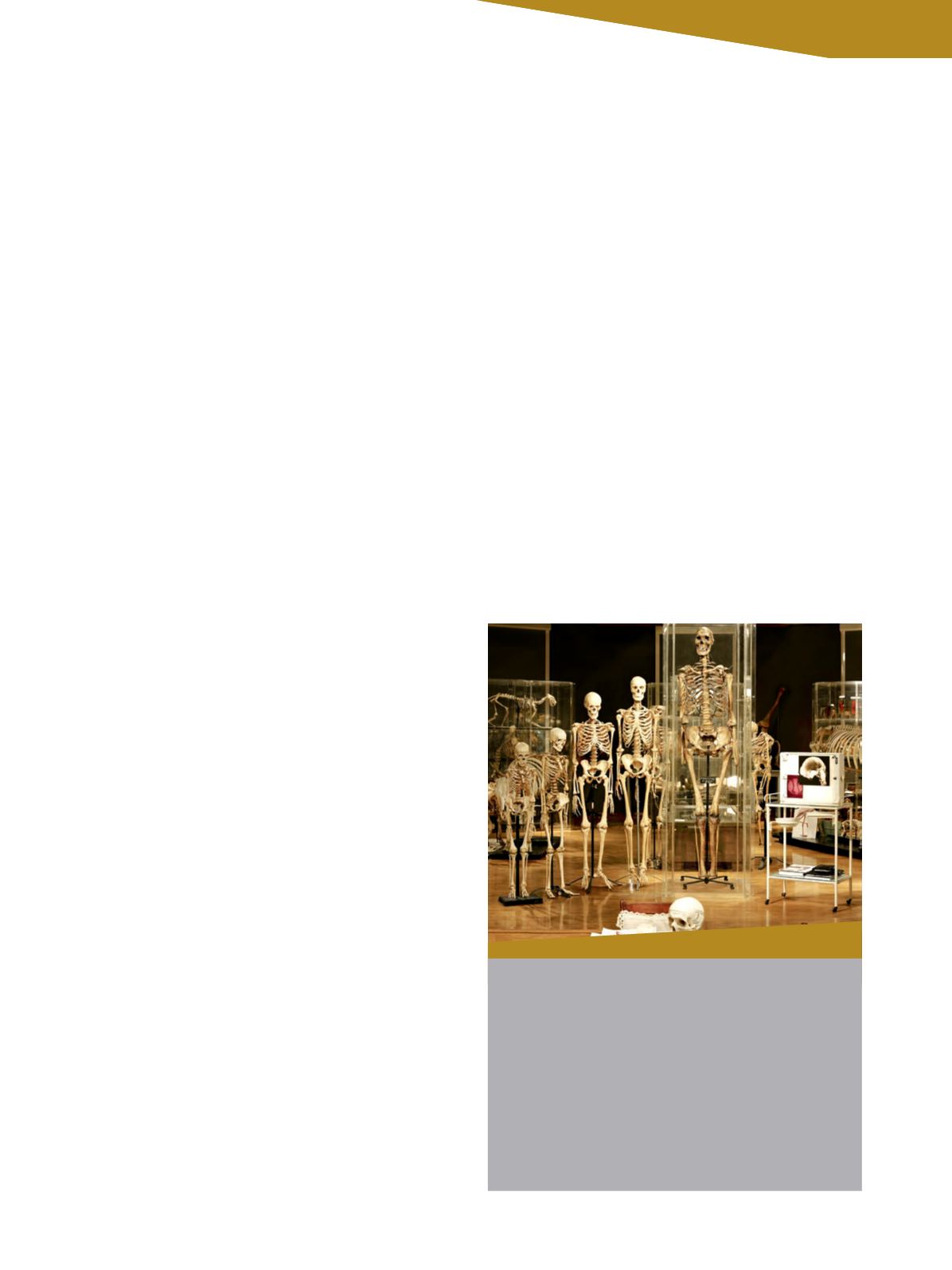

WELCOME
||
113
ANATOMISCHE SAMMLUNGEN
Medizinische Universität Innsbruck, Müllerstrasse 59,
Kontakt: Romed Hörmann, +43 512 900371113,
romed.hoermann@i-med.ac.atÖffnungszeiten: Donnerstag von 15:30 bis 18:00 Uhr
ANATOMICAL COLLECTIONS
Medical University of Innsbruck, Müllerstrasse 59
Contact: Romed Hörmann, +43 512 900371113,
romed.hoermann@i-med.ac.atOpening hours: Thursday, 3:30 to 6 p.m.
D
er Herr Haidl war ein Riese – gemessen an heutigen Verhältnis-
sen. Gemessen an der Durchschnittsgröße vor 500 Jahren war er
ein Gigant. Die betrug nämlich 1,65 Meter. Herr Haidl aber war
zwei Meter zwanzig groß und im damals noch überschaubaren Inns-
bruck ein Mann, der alles und jeden überragte. Und auffiel. Besonders
dem damaligen Regenten, Erzherzog Siegmund dem Münzreichen. Da
Nikolaus Haidl wahrlich ein imposanter Geselle war, engagierte Sieg-
mund ihn prompt als Leibtrabant. Und nicht nur das, er gab ihm darüber
hinaus auch eine seiner unehelichen Töchter – er hatte genügend da-
von – zur Frau und ließ den beiden ein standesgemäßes Domizil errich-
ten: in der Hofgasse Nr. 12 in der heutigen Innsbrucker Altstadt.
Baumeister des gotischen Hauses ist vermutlich Niclas Türing der
Ältere, der übrigens auch für das Goldene Dachl verantwortlich zeich-
net. Im Vergleich zu den Nebenhäusern fallen insbesondere die ho-
hen Stockwerke auf – angepasst an seinen Bewohner. In das Eckhaus
nebenan sollte einige Jahrzehnte später übrigens der berühmteste
Hofzwerg seiner Zeit einziehen, der angeblich 65 Zentimeter kleine
Thommele, der am Hofe Ferdinands II. diente.
Wie man heute weiß, litt Nikolaus Haidl an Akromegalie, einer Er-
krankung, die seinen riesenhaften Wuchs bedingte und ihm gleich-
zeitig ein vorzeitiges Lebensende bescherte. Mit knapp über 30 Jah-
ren, im Jahr 1491, verstarb der „Burgriese“. Dass man heute so viel
über ihn weiß – und aktuell gerade wieder genauer nachforscht –,
verdankt man einem Zufallsfund im Jahr 1886. Bei Arbeiten im Inns-
brucker Dom fand man eine Menge menschlicher Gebeine. Und so,
wie Nikolaus Haidl während seiner Lebzeit auffiel, tat er es auch im
Tode. Die riesigen Knochen erregten sofort Aufmerksamkeit. Heute
sind seine Überreste im Anatomischen Museum der Medizinischen
Universität Innsbruck ausgestellt. Eine Statue des Riesen, vom Er-
bauer seines Hauses erschaffen, befindet sich im Alten Rathaus.
Das Burgriesenhaus in der Hofgasse hat übrigens noch eine weite-
re Besonderheit: Das spätgotische Portal hat einen eigenen Namen –
Flüsterbogen wird es genannt. Die Worte, die am einen Ende in den
Bogen geflüstert werden, können am anderen Ende gut vernommen
werden. Schade, dass das Haus nicht selbst erzählen kann ... Aber wer
weiß, vielleicht hört man sie manchmal ja noch, die dumpfen Schrit-
te des Riesen auf den Dielen im alten Haus.
||
H
err Haidl was a giant, as measured by present-day standards.
Measured by the average height of 500 years ago, which was a
mere 165 centimeters, he was positively Brobdingnagian. Herr
Haidl was two meters tall and a man, in the Innsbruck of his day, which
was not a big town, who towered over everything and everybody. And
who was noticed. Especially by the ruler at the time, Archduke Sieg-
mund der Münzreiche. As Nikolaus Haidl was indeed an imposing fig-
ure, Siegmund promptly engaged him as a bodyguard. And not only
that, he also gave him one of his daughters, he had plenty of them, for
a wife and had a domicile befitting the couple’s rank built for them at
number 12 Hofgasse, in today’s Old Town of Innsbruck.
The architect of the Gothic house probably was Niclas Türing the
Older, who was also responsible for the Goldenes Dachl, by the way.
What is remarkable about it, when compared to its neighboring hous-
es, is the height of its stories, which was adapted to the prospective in-
habitant. The most famous court dwarf of his time, Thommele, who is
said to have measured a mere sixty-five centimeters, and who served
at the court of Ferdinand II, should move into the corner house next-
door several decades later. As we know today, Nikolaus Haidl suffered
from acromegaly, an illness that caused his gigantic size and brought
him to an early death. The Burgriese (lit. castle giant) died, aged little
more than thirty years, in 1491.
The fact that we know so much about him today, and that current-
ly new research is being undertaken in relation to him, is owing to an
accidental discovery in the year 1886. During works on Innsbruck Ca-
thedral, a great number of human bones were found. And just as he did
during his lifetime, Nikolaus Haidl also stood out in death. The huge
bones immediately caused a sensation. Today, his remains are exhibit-
ed at the Anatomical Museum of the Medical University of Innsbruck. A
statue of the giant, created by the architect of his house, can be found
at the Old City Hall.
The Burgriesenhaus at the Hofgasse has another peculiarity, by the
way. The late Gothic portal is known by a special name. It is called the
Flüsterbogen (lit. whispering arch). The words whispered at one end in-
to the arch can be heard perfectly clearly at the other end. It’s a shame
that the house itself can’t talk ... But who knows, maybe we are still
able to hear them at times, the thudding footsteps of the giant on the
floorboards of the old house.
||
©MEDIZINISCHEUNIVERSITÄT INNSBRUCK
















